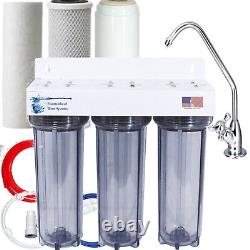3 Stage Clear Under Sink Water Filter System Sediment/Fluoride Arsenic Filters


3 STAGE UNDER SINK FILTER. CLEAR HOUSINGS VISUALLY CHECK FILTERS. 3 2.5" X 10" Clear Filter housings on bracket. 2nd stage Activated Alumina for Fluoride/Arsenic removal.
Feed Water Valve for standard installation. Fluoride/Arsenic is not normally removed through the filtration process.
It can be removed through reverse osmosis, this filter is designed to remove the fluoride through filtration using Activated Alumina. Activated alumina (AA) is the only filter material specifically designed to remove fluoride and arsenic from water.A ceramic compound made of aluminum oxide with a very high surface-area-to-weight ratio, AA has a very high capacity for fluoride adsorption. Most municipal water supplies add 2 ppm (parts per million) of fluoride. AA filters can reduce fluoride concentrations to below. 1 ppm, or down to 99% of the normal fluoridated water level.
If you are concerned about these contaminants in your water supply, this is the ideal low cost system for you. Carbon block is a type of charcoal filter that is so densely compressed that even microscopic bacteria cannot penetrate.
Unlike loose granular charcoal filters that are inexpensive and commonly found in supermarkets or hardware stores, these filters force water to penetrate through an enormous surface area. Due to a special activating process, complex geometric lattices are created that increase the absorptive area. Since charcoal is like a sponge for chlorine, pesticides, gases, and many other organic compounds, the more time water spends going through it, the cleaner it gets. Our more advanced carbon block designs can also remove very high percentages of heavy metals such as lead, and bacteria and cysts such as E. Coli, protozoa, giardia, and cryptosporidium.Carbon also removes - Volatile organic chemicals, or VOCs, are often toxic chemical compounds used industrially that may be present in water sources. A variety of fuels, solvents, coatings and refrigerants are volatile organic chemicals. Activated charcoal effectively traps and absorbs many different VOCs. Chlorine - No other filter removes chlorine and its accompanying odor and flavor as well as an activated charcoal filter.
Most municipal water sources are treated at one or more stages with chlorine to kill bacteria. Pesticides - The Environmental Protection Agency lists activated charcoal filters as the only way to reduce pesticide quantities in drinking water.
Many different pesticides used today are leached into our water sources and cause contamination. All of our sediment filters use multi-gradient spun polypropylene filter cartridges. These cartridges use the entire depth of their media by trapping the largest sediment particles on the outside of the filter, then gradually stepping down the size of particles they will reject as the water moves closer to the core of the filter. The result is longer filter life, greater dirt-holding capacity, higher flow rates, and remarkably low pressure drop.
The 100% pure polypropylene media is highly resistant to bacteria and chemicals, making this an excellent choice for both well water and municipal water treatment applications. Q: Why don't filtration systems reduce TDS? "Filtration" systems are designed to selectively remove contaminants and to leave in dissolved trace minerals such as calcium and magnesium.These water-borne minerals are healthful and give water a more natural flavor. Systems that remove minerals lower the pH of water and cause it to be more aggressive. Low pH water will seek to balance itself by leaching elements such as copper, lead or aluminum from plumbing fixtures and cooking utensils. Cooking in de-mineralized water will also draw the minerals from your foods causing a reduced nutritional value. Water with a balanced mineral content has a much less tendency to take on foreign elements.
TDS (total dissolved solids) is primarily made up of dissolved minerals and is not related to harmful contaminants. A TDS tester is for testing the efficacy of a reverse osmosis system. Q: Why would the filtered water from the unit appear cloudy sometimes? Occasionally, filtered water may appear milky or cloudy.
The siphon action in closing the faucet can create air pockets in the filter. These air pockets will produce tiny air bubbles in the filtered water that can cause the appearance of. This is especially noticeable also when you first install new filters. The highly fractured structure of carbon and other media contains a lot of trapped air. This should fade in a few days. Visit our store for more configurations and systems, as well as replacement filters and spare parts. International Buyers - Please Note. We do not mark merchandise values below value or mark items as "gifts" - US and International government regulations prohibit such behavior.
